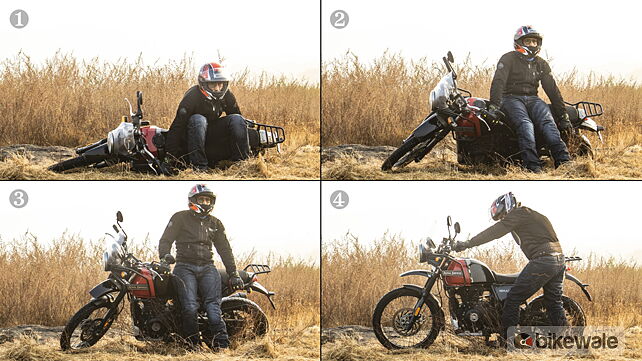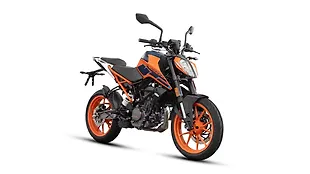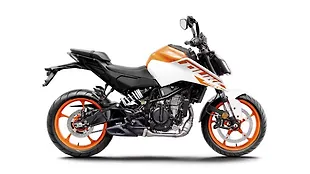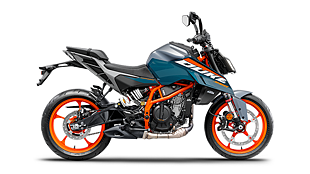Introduction

We want to clear two things up front. One, between the KTM 250 Adventure and 390 Adventure, the 250 is the better option especially for those who aren’t brilliant at off-roading. Which would mean an overwhelming majority.
Two, the price difference between the 250 Adventure and the current go-to bike when it comes to on/off road performance on a budget (with agreeable amount of torque) – the Royal Enfield Himalayan – is a tad under Rs 55,000. The latter retails for Rs 2.35 lakh on the road in Mumbai, while the KTM is priced at Rs 2.89 lakh on the road.
A significant difference, agreed. But not an insurmountable one, surely. Not, with five to seven year loans and manageable EMIs. The question then is – is the KTM that much better than the Himalayan to command such a premium? Or, does it still make more sense to go for the Royal Enfield?
Looks and Styling

When it comes to looks, we’d take the KTM. It looks like a proper ADV. It has more road presence. And it looks like it has been designed to take both the rough and the smooth in its stride, and with poise, charm and comfort. The Himalayan on the other hand looks more utilitarian. Tubes and simple metal panels define it. And, no flair whatsoever. Now, many may argue that there’s charm in simplicity. But, when I am spending upwards of Rs 2 lakh, I’d take some flamboyance as part of the package, thank you.
Ergonomics and Quality
Upright ergos. That’s the name of the game with both motorcycles. But, one more than the other. The Himalayan with its higher handlebar, lower and more forward set footpegs, and a lower seat height makes for a more upright and comfortable seating triangle. It also feels roomier for taller riders, as a result. And lest we forget, it’s the better motorcycle here to stand up and ride on as well.

The KTM’s footpegs, on the other hand, are higher and more rearset. The handlebar-seat relation in both the X and Y planes it tighter as well. Add to this a wider handlebar and the 250 ADV offers a sportier and more intuitive motorcycle-rider interface compared to the Himalayan. And therefore, the 250’s ergos seem nicer when filtering through traffic or taking on the twisties. Additionally, it also has a wider, better-padded rider and pillion seats.
We’d also rate the KTM higher on quality. The look and feel of parts, the fit and finish, and the overall refinement and operability levels comes across as better engineered on the 250.
Features and Technology

Like we said at the start – the Himalayan brings simplicity into the mix. And it’s not just limited to design.
Just to set the context, the KTM comes with a completely digital and info-rich instrumentation. It gets backlit switchgear. It comes with knuckle guards, an engine guard, adjustable windscreen, and fair amount of LED lighting. The latter includes the tail lamp and the turn indicators. It also comes with alloy wheels and tubeless tyres. And upside down front forks. Plus there’s a slipper clutch.

The Himalayan doesn’t get any of this. It has a part-analog-part-digital display, but it isn’t as comprehensive or good looking as the KTM. To give the bike its due, it does get disc brakes with ABS on both the front and rear wheels, with the option of switching off the ABS on the latter. But then again, so does the KTM.
Engines and Performance

The Himalayan has the bigger engine here, while the KTM has the more advanced powertrain. The latter gets liquid cooling, a four-valve head, and a six-speed gearbox. The Royal Enfield in the meantime has to make do with a two-valve, air / oil cooled engine mated to a five-speed gearbox. The KTM not surprisingly makes more power. But, it’s the Himalayan that packs in significantly more torque.
As is expected of a KTM, the 250 ADV is happiest in the mid and top end of the engine rpm band. It feels slow and boring and lazy and disinterested till it gets past 4,000rpm. Post that there’s a slight spring in its step. But, it really comes on song post 6,000rpm.

And when it does, the 250 feels fast but manageable; alert but friendly; and with the throttle pinned it can hit close to 140kmph as well. But, it feels best when cruising between 100-110kmph in sixth gear. The engine doesn’t feel frantic, there are no bothersome vibes, and it still has enough in reserve at these speeds to make a quick overtake.
The Himalayan too feels good when cruising at 100kmph; it is relaxed and unhurried. But, unlike the 250 ADV, it doesn’t have a lot in reserve when cruising at three digit speeds. The Royal Enfield’s ace, however, is its torque, its low and mid range performance, and its strong pulling power no matter the gear or speed or incline. This tractability also makes it the friendlier powertrain option when riding off-road.
Ride and Handling

In fact, the Himalayan is the better of the two motorcycles to spend a day off-roading on, period. It’s easier to pick up when you drop it; it’s heavier weight notwithstanding. It’s less demanding to tackle slippery inclines or steep slopes with. And because it has a bigger front wheel and more torque lower down in the rpm range, it is the better motorcycle to handle obstacles with. And it has a better, more comfortable ride quality – on and off road.

On the road, however, the KTM is king. It has a quicker, more stable turn-in; it has more cornering clearance; it feels more stable when leaned over; it’s happier making quicker direction changes; and courtesy its stronger, more progressive brakes it’s also easier to ride harder around a twisty road. And, it’s the better of the two when it comes to filtering through traffic.

Fuel Efficiency and Price

With its torquier engine, wider spaced gear ratios, and a non-hurried outlook, the Himalayan should have been more fuel-efficient. That’s if it wasn’t almost 20kg heavier than the KTM. As it turns out, both motorcycles deliver very similar fuel efficiency figures; in the low to mid thirties. Pricing wise the Royal Enfield has a huge advantage, of course. It’s almost Rs 55,000 cheaper to buy than the KTM.
Verdict

Let’s get the obvious out of the way first. The Himalayan is the better motorcycle off-road. The 250 ADV is the one to go for if on road riding and touring is all one is looking at. But, life isn’t that simple. And we almost always want more.
So, to the more complicated bit (and our reason for being here) – is the KTM that much better to justify the price premium over the Himalayan as an overall ADV package? The short answer is – yes.

It is easier to tackle cities with; it is quicker and more stable on fast highway runs; it is more intuitive, more agile, and more confidence inspiring around the twisties; and it has better seats. So, when it comes to spending long hours on the bike, the KTM has your back. It also has more features and tech. And it looks more purposeful and striking and richer than the Royal Enfield.
Yes, it isn’t as comfortable as the Himalayan. And it’s more work on trails, rocks, and rutted inclines. But it’s not bad. And honestly, given its ability and the stuff it packs in, it comes very close to justifying its price premium. But more than that, between the two, as an overall ADV package to live and breathe and ride and enjoy, the KTM 250 Adventure does a better job than the cheaper, torquier, and simpler Himalayan.
Final Scores
| Parameters | Max Points | KTM 250 Adventure | Royal Enfield Himalayan |
|---|---|---|---|
| Looks & Styling | 10 | 8 | 7 |
| Ergonomics & Quality | 10 | 7 | 7 |
| Features & Tech | 10 | 7 | 5 |
| Engine & Gearbox | 10 | 8.5 | 8 |
| Performance | 10 | 7 | 6 |
| Ride Quality | 10 | 7 | 8 |
| Handling & Braking | 10 | 8 | 7 |
| Fuel Efficiency | 10 | 4 | 4 |
| Price & Warranty | 10 | 3 | 3 |
| Desirability | 10 | 7.5 | 7 |
| Total | 100 | 67 | 62 |
Photography by Kapil Angane
Gallery
1/12
KTM 250 Adventure Right Side View
Double Tap to Zoom





















![KTM 250 Adventure [2021] Image KTM 250 Adventure [2021] Image](https://imgd.aeplcdn.com/272x153/bw/models/ktm-250-adventure-standard20191203140505.jpg?q=80)
























![KTM 390 Adventure X [2025] KTM 390 Adventure X [2025]](https://imgd.aeplcdn.com/272x153/n/cw/ec/190885/390-adventure-x-2025-right-side-view.jpeg?isig=0&q=80)